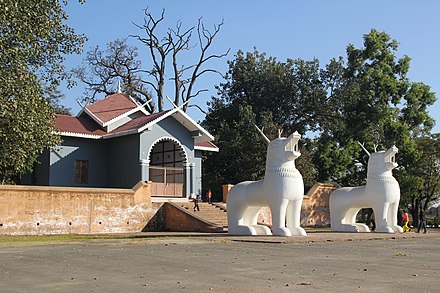Manipur - state in North-east India
To enter Manipur, travellers must have a negative COVID-19 RT PCR test report issued 48 hours before the time of travel. Travellers arriving from countries categorised as 'At Risk' are required to undergo a mandatory RT-PCR test upon arrival and follow a 14-day self-quarantine procedure, excluding some exceptions. Lockdowns and curfews may apply in some districts.
For the latest information, check the Manipur Health Directorate Website.
Manipur (Manipuri: ꯀꯪꯂꯩꯄꯥꯛ, Kangleipak) is a North-Eastern India state, rich in history, culture and natural beauty. Ancient Manipur was one of Asia's oldest human civilisations. It was known for the arts, language, philosophy, politics and sports. Besides its cultural heritage, the blue mountains and the bowl like central plain draw many tourists from far away. Loktak lake, the world's only floating lake, is known as the "Mirror of Manipur".
Manipur is also known as "Switzerland of the East", "Jewel of India" and "Maid of the Mountains". Besides these, it is also called "Gateway to South East Asia" for its strategic location in India connecting with the South East Asian countries. Other than Manipur, there is no well developed land route in India to connect with the ASEAN nations.
Manipur has been at the crossroads of Asian economic and cultural exchange for more than 2,500 years, connecting the Indian subcontinent and Central Asia to Southeast Asia, East Asia, Siberia, regions in the Arctic, Micronesia and Polynesia. This strategic geographical location enables the migration of people, cultures and religions, to and from all sides.
Regions
Manipur has both mountainous as well as plain regions with countless islands spread over the Loktak lake in the middle of the central bowl like plain.
Manipur is broadly divided into plain districts (Imphal East, Imphal West, Bishnupur, Jiribam, Kakching, Thoubal) and hill districts (Chandel, Churachandpur, Kamjong, Sadar Hills/Kangpokpi, Noney, Pherzawl, Senapati, Tamenglong, Tengnoupal, Ukhrul). Imphal East (Andro, Porompat)
It is the place where one of the earliest human settlement in Manipur emerged - Andro, where there's a sacred fireplace burning continuously for the last couple of millennia (2000 years), through the dedicated efforts of the natives.
Ima Market, the world's only women run market, Imphal Polo Ground, the world's oldest pologround and Kangla, the ancient fortified capital city is in the middle of this district. Samban-Lei Sekpil, the world's tallest topiary plant, grows in this district. This district also has most of the administrative and official zones in Manipur.
Bishnupur (Moirang, Thanga, Loktak Lake)
Loktak lake, the world's only floating lake, spreads her major portion in this district. It houses Keibul Lamjao National Park, the only floating national park in the world, which is the last natural habitat for Brow antlered deer (Cervus eldi eldi), the world's only dancing deer species. Thanga is the largest island in the lake, hosting numerous tourist destinations.
It is the meeting point of the Meitei culture and the rest of the Indian tradition. This district borders Assam in the west.
It is also known as the "Rice Bowl of Manipur" or "Granary of Manipur", for producing the highest level of grains, especially rice in Manipur. Kakching is the cleanest city in North East India. It has the highest literacy rate in Manipur.
The Anglo-Manipuri War Memorial Complex (popularly known as Khongjom War Memorial Complex) is the resting place of many freedom fighters and martyrs of Manipur.
Sirohi National Park is the world's only habitat for Shirui Lily (Lilium macklineae), the world's only terrestrial lily species.
Cities
Major cities include:
- Imphal (ꯏꯝꯐꯥꯜ) 📍 — the metropolis and the largest city of Manipur state, most of the archaeological and historical sites are concentrated here
- Bishnupur (ꯕꯤꯁ꯭ꯅꯨꯄꯨꯔ) 📍 — housing the first Hindu temple built in Manipur - Bishnu Temple (Vishnu Temple)
- Kakching (ꯀꯛꯆꯤꯡ) — the cleanest city in North East India, the region with the highest literacy rate in Manipur, the highest level of grain production in Manipur and thus, the sobriquets – "Rice Bowl of Manipur" or "Granary of Manipur"
- Lamphelpat (ꯂꯝꯐꯦꯜꯄꯥꯠ) 📍 — Capital city of the Western Imphal Division
- Moirang (ꯃꯣꯢꯔꯥꯡ) — Known as the "Cradle of Manipuri culture", this region has a lion's share with the granary of the diverse Manipuri culture
- Moreh (ꯃꯣꯔꯦꯍ) 📍 — India's only developed place to the Trilateral Highway aka Asian Superhighway towards Thailand and other ASEAN nations
- Porompat (ꯄꯣꯔꯣꯝꯄꯥꯠ) — Capital city of the Eastern Imphal Division
- Thoubal (ꯊꯧꯕꯥꯜ) 📍 — best known for the Anglo-Manipuri War Memorial Complex (aka, Khongjom War Memorial Complex), the largest in North East India
Other destinations
-
Keibul Lamjao National Park 📍 — the world's only floating national park, because of decomposed plant materials and part of the Loktak Lake ecosystem. It provides the natural habitat for the endangered Eld's deer or brow-antlered deer (Sangai deer), the only dancing deer species of the world. It is an annual destination place for many migratory birds, including the Siberian cranes, during winter. It is also home to a variety of mammals, birds, amphibians and reptiles.
-
Andro (ꯑꯟꯗ꯭ꯔꯣ) 📍 — housing a 2000 years old fireplace still burning in a protected sacred site
-
Sirohi National Park 📍 — Also called Shirui National Park, this park near Ukhrul is the only habitat for the world's only terrestrial lily species, the Shirui lily (Lilium macklineae), and also has tigers, leopards and a variety of rare bird species such as the Blyth's tragopan. The Shirui peak during monsoon season is covered with the blooms of the exotic lily. Despite multiple serious experiments of numerous scientists, this lily species can't be grown anywhere else on Earth.
-
Thanga (ꯊꯥꯡꯒꯥ) 📍 — the largest island in Manipur and one of the most common boating adventure zones in Manipur, the world's only floating national park - Keibul Lamjao National Park is also under its geo-political jurisdiction but outside the main island
-
Yangoupokpi-Lokchao Wildlife Sanctuary — This sanctuary hosts the unique and vibrant biodiversity of the Indo-Myanmar region because of its strategic location in the juncture of the two major geographical zones.
-
Ukhrul/Hunphun (ꯎꯈ꯭ꯔꯨꯜ) 📍 — a small town housing Sirohi National Park, the world's only habitat for the world's only terrestrial lily, Shirui lily (Lilium macklineae). It's also the home of the Tangkhul Nagas. It is the administrative headquarters of the Ukhrul district.
Understand
Manipur is bordered by Assam in the west, Nagaland in the north, Myanmar (Burma) in the east, and Mizoram in the south.
The state is a melting pot of different cultures and languages. In Manipur, people are legally classified as non-tribal groups and tribal groups. All the non-Meiteis are considered tribals, giving governmental privileges in every sectors. The Meitei people (popularly called Manipuri speaking people) comprise the vast majority of the population, although there is a sizeable population of the Nagas (the largest minority group) and other various tribal groups. Tribesmen communities are native to the hill districts while the Meiteis are mainly predominant in the central plain and other valleys, including Jiribam and Moreh. Hinduism and Christianity are the dominant religions in the state. Sanamahism is the only ancient religion indigenous to Manipur. After a long suppression of three consecutive centuries, it is reviving and is the fastest growing religion in Manipur.
Manipur has long connected the Indian subcontinent to Southeast Asia, enabling the migration of various cultures and languages to and from the two regions, and the state is credited for introducing the sport of polo to Europeans.
As with several states in North-Eastern India, Manipur has faced a violent, often brutal, insurgency. The parallel rise of the Naga insurgency in the hill districts and the fact that there are elements of ethnic and tribal nationalism in the insurgent movement have made the situation very complex.
Although the worst of the violence may have come to an end with many rebel groups having since surrendered peacefully to the Indian government, some issues caused by the insurgency still persist.
Talk
Meitei (popularly called Manipuri) is the official state language and is the native language of the vast majority of the population, although an English speaking visitor will not encounter significant language problems. English is the second most widely studied and understood language next to Meitei, followed by the local tribal languages. At least some basic knowledge of English can be expected from almost most of the population in the tourism industry and public transport services. However, learning a few Meitei terms, like "hello", "how are you" and "thank you" will be warmly welcomed.
Some people in Manipur can communicate in Hindi similar to its neighbouring states, but nearly everyone in Manipur is better in communicating in English over Hindi and locals too prefer communicating in English over Hindi.
Get in
Travellers used to have to have an Inner-line permit, but it may no longer be required; check before you go. If you are an Indian citizen but don't reside in Manipur, you need the permit. However, if you are not an Indian citizen, no special permits are required and your Indian visa is enough.
By plane
 Imphal Airport (IATA: IMF) is the largest in Manipur, second largest and the third busiest in North East India. Several airlines transport passengers to and from Manipur and other places. AirAsia India serves transportation to Delhi, Guwahati and Kolkata. Air India has flights to Aizawl, Delhi, Dimapur, Guwahati and Kolkata. Alliance Air serves transportation to Dimapur and Guwahati. IndiGo serves transportation to Agartala, Ahmedabad, Bangalore, Delhi, Dibrugarh, Guwahati, Hyderabad, Mumbai, Kolkata and Shillong.
Imphal Airport (IATA: IMF) is the largest in Manipur, second largest and the third busiest in North East India. Several airlines transport passengers to and from Manipur and other places. AirAsia India serves transportation to Delhi, Guwahati and Kolkata. Air India has flights to Aizawl, Delhi, Dimapur, Guwahati and Kolkata. Alliance Air serves transportation to Dimapur and Guwahati. IndiGo serves transportation to Agartala, Ahmedabad, Bangalore, Delhi, Dibrugarh, Guwahati, Hyderabad, Mumbai, Kolkata and Shillong.
By road
Manipur can be entered by roadways from any of its land neighbours. From Myanmar, Assam and Nagaland, there are international highways, national highways and inter-state highways to Manipur. From Myanmar, Manipur can be entered through Moreh, the Indo-Myanmar border commercial hub. From the eastern side (Myanmar), the most popular route to Manipur is the Indo-Myanmar Highways (Imphal-Moreh Highway). From the western side via Assam, the most popular route to Manipur is the Imphal-Jiribam Highway. From the northern side via Nagaland, the most popular route to Manipur is the Imphal-Dimapur highway. As of now, route for the southern side (Mizoram) is under construction.
By train
Indian Railways connect Manipur with the rest of country's regions through Jiribam. As of 2022, the world's tallest railway bridge is under construction in Noney district of Manipur.
Get around
By bus
Inter district buses and inter city buses are good options for domestic travel across Manipur, both plain and hill districts. The Inter State Bus Terminus in Imphal is the meeting point of every bus services in Manipur.
By car
Exploring Manipur by car can be an awesome experience, allowing you to explore the incredibly scenic and varied terrains of the Manipur's central plain, surrounding hills and mountains, river valleys and lake islands, at your satisfaction. Most roads are well-marked and well-maintained due to the rapid expansion and the improvement of the international highways, national highways, inter-state highways and intra-state highways in Manipur. Road signs in Meitei (Manipuri) are usually repeated with the respective English language translations or Latin-Roman script transliterations.
By boat
 Getting around the islands (human inhabited as well as non-human inhabited) of the Loktak lake in the central bowl like plain of Manipur, is usually done with boat rides. Boats of various types are available. Motor boats, canoes, fishing boats, kayaks, house boats, rowboats, sailing boats are some of the common types of boats travellers usually choose.
Getting around the islands (human inhabited as well as non-human inhabited) of the Loktak lake in the central bowl like plain of Manipur, is usually done with boat rides. Boats of various types are available. Motor boats, canoes, fishing boats, kayaks, house boats, rowboats, sailing boats are some of the common types of boats travellers usually choose.
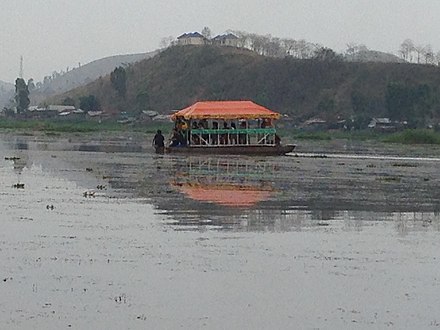 One of the most popular boatyards is in the shoreline foothills of the Sendra hillock in Thanga (outside the Thanga main island but under its geopolitical jurisdiction). Others are almost all the shoreline peripheral regions of the Loktak lake, especially Thanga and Moirang.
One of the most popular boatyards is in the shoreline foothills of the Sendra hillock in Thanga (outside the Thanga main island but under its geopolitical jurisdiction). Others are almost all the shoreline peripheral regions of the Loktak lake, especially Thanga and Moirang.
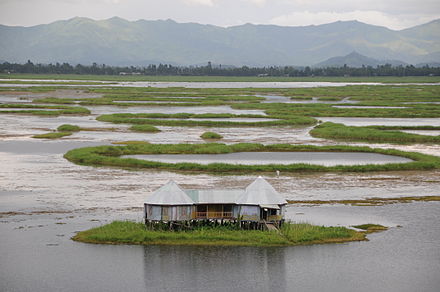 Hundreds of buoyant restaurants and hotels are floating around the Loktak lake, giving services to the travellers. Staying one or two nights at these floating lodges is a unique experience for people who are fleeing from noisy city life.
Hundreds of buoyant restaurants and hotels are floating around the Loktak lake, giving services to the travellers. Staying one or two nights at these floating lodges is a unique experience for people who are fleeing from noisy city life.
See
Few Asian provinces can pride themselves on a heritage as important to oriental civilization as Manipur. A range of the classical historic landmarks remind one of the days when the great Meitei rulers and authors made their mark on the development of culture, literature and sports.

Cultural heritage
in the heart of Imphal, the metropolis of Manipur](https://upload.wikimedia.org/wikipedia/commons/thumb/e/ed/Manipur_Polo.jpeg/440px-Manipur_Polo.jpeg)
The world's oldest Polo Ground is the Imphal Polo Ground (Manipuri: Mapal Kangjeibung) in Imphal. Its earliest record of existence dates back to 15th century BC (3500 years ago).
Manipur is the birth place of polo and the fact is already supported by the Guinness World Records, by a declaration in the year 1991, as:
<blockquote><poem> "Polo can be traced to [origins in Manipur state](w:simple:Origin_of_Polo) __c. 3100 BC__, when it was played as Sagol Kangjei." </poem></blockquote> _Guinness World Records, 1991, page no. 706. , the world's only women run market, is in [Imphal](Imphal).](https://upload.wikimedia.org/wikipedia/commons/thumb/5/5d/Imphal%2C_Manipur_(62).jpeg/440px-Imphal,_Manipur_(62).jpeg) [Ima Keithel](w:simple:Ima_Keithel) (literally, Mothers' Market) is the world's only market run exclusively by women. The Government of Manipur has announced that the male shopkeepers are illegal inside the market complex. The existence of this unique market dates back to medieval times. The market has 3 major complexes with altogether holding a capacity of around 5000-6000 vendors. 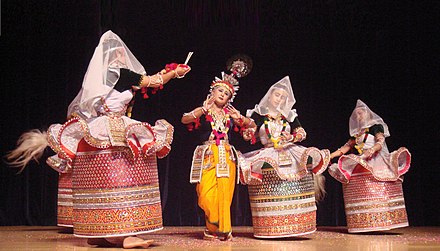 The [Manipuri Raas Leela](w:Manipuri_Raas_Leela) is one of the 8 classical dance forms of India. It draws attention to numerous culture enthusiasts across the globe.Natural beauty
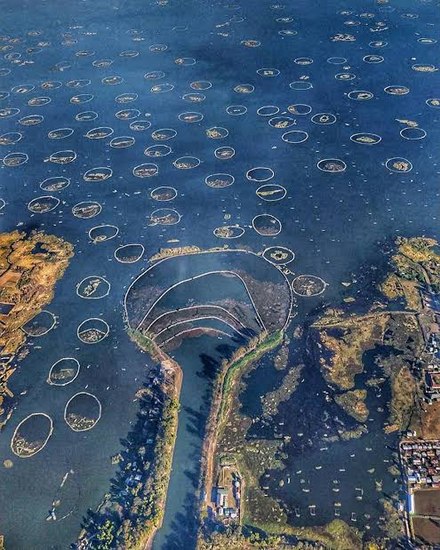
- Loktak Lake — world's only floating lake, best known for the circular floating biomasses (Manipuri: phumdi).
- Keibul Lamjao National Park — world's only floating national park, buoyant on the Loktak lake. It is the last and the only natural habitat for the brow antlered deer (Cervus eldi eldi), the world's only dancing deer species. It is in Thanga jurisdiction (not inside the Thanga main island).
- Sirohi National Park in Ukhrul — It is the world's only habitat for the world's only terrestrial lily species, Shirui lily (Lilium macklineae). Despite multiple serious attempts to plant it elsewhere in the world other than its native place by numerous scientists, it is still unsuccessful.
- Yangoupokpi-Lokchao Wildlife Sanctuary — This sanctuary hosts the unique and vibrant biodiversity of the Indo-Myanmar region because of its strategic location in the juncture of the two major geographical zones.
Do
- Backpacking, bikepacking, bushwalking, camping, fastpacking, hiking, hillwalking, mountaineering, rambling, tramping and trekking are some of the most common outdoor activities adventure lovers usually do in the mountains, hills, hillocks and woodlands of Manipur.
- Canoeing, fishing, house boating, kayaking, motor boat riding, pontoon boating, rowing are some of the most common activities adventure lovers usually do in the lakes and the rivers of Manipur.
- Plogging is becoming more common nowadays in Manipur. Many plogging events have attracted numerous participants. Besides normal regular ploggings, these are done at the massive levels on special days, like Earth Day (April 22), World Environment Day (June 5), etc.
- Loukoipat, Bishnupur (Moirang).
Eat
 Manipuri cuisine is a blend of indigenous traditions and outside influences. Mainland India have left significant impacts on modern Manipuri cuisine. The traditional Meitei diet is very oriental, espousing fish, grains, herbs and vegetables native to the Asian biome. Rice is a staple food. Being highly dependent on the Loktak Lake, the Meiteis incorporate plenty of aquatic food into their diet, especially fish. Manipur is also a remarkable producer and consumer of fish, pork and chicken. Wines are legally allowed for tribes but not for the Meiteis (excluding Chakpa castes) since they are legally not tribes.
Manipuri cuisine is a blend of indigenous traditions and outside influences. Mainland India have left significant impacts on modern Manipuri cuisine. The traditional Meitei diet is very oriental, espousing fish, grains, herbs and vegetables native to the Asian biome. Rice is a staple food. Being highly dependent on the Loktak Lake, the Meiteis incorporate plenty of aquatic food into their diet, especially fish. Manipur is also a remarkable producer and consumer of fish, pork and chicken. Wines are legally allowed for tribes but not for the Meiteis (excluding Chakpa castes) since they are legally not tribes.
- Chamthong or Kangshoi is a stew preparation of any seasonal vegetables with coarsely chopped onions, maroi, ginger and salt, topped with ngari, fried fish pieces (optional) and water. It's soupy in nature and is eaten with rice.
- Eromba- Vegetables and potatoes boiled with a lot of red chillies or Umorok with ngari (fermented fish), dry fish and mashed together.
- Morok metpa is a coarse-paste prepared with green or dry red chillies. They should be boiled with ngari in a pan and then it should be mashed with salt; fried fish pieces can also be added to it. chopped onions and coriander leaves should be added to it and mixed. Other dishes are- kang-hou (various vegetables fried dry in oil with traditional spices), paknam (fish cake), nga-thongba (fish curry), ooti, pakora thongba, chagem pomba, keli chana, alu kangmet (boiled potato mashed with fried red chilli and salt and dressed with mustard oil), sana thongba which is prepared with paneer in Manipuri style, a-nganba (steam vegetables, such as pumpkin, sweet pea, carrots, and French beans).
- Singju is a salad prepared with finely chopped cabbage, onions, lotus stems, tree beans, coriander leaves, sinju pan, ginger, heibi mana and lots of seasonal vegetables mixed with ngari. Boiled kidney beans are optional and the dish is seasoned with red chilli flakes, salted to taste, with red roasted sesame powder and roasted chick peas powder.
- Umorok – literally ‘tree chilli’ u=tree; morok = chilli. It is garnished with maroi (maroi namakpi, maroi nakuppi, awa phadigom, mayang-ton, toning-khok tilhou, coriander leaves).
Drink
Tea and coffee
In Manipur, tea is more popularly consumed as compared to coffee. Tea is readily available in almost all the hotels but you can't expect the same thing for coffee. Both drinks are not native to Manipur. So, there are no Manipuri terms for these drinks. The common Indian term "Chaa" (not "Chai") is used to refer to tea and for coffee, it's the same pronunciation - "Kofee".
Alcoholic beverages
The Manipuri collective term for all liquors like alcohol, beer, wine, etc. is "Yu" ("Yoo"). It's common among the tribal people of the hills of Manipur. Among the majority Meiteis (they are non-tribals), it's not legally allowed. However, the Chakpa caste inside the Meitei ethnicity is an exception. The Chakpa dominated areas like Andro, Kakching, Khurkhul, Sekmai, etc. have some of the most famous breweries in Manipur. In some Chakpa villages, the term "wanglei" (/waang-lei/) is used instead of the general term "Yu" ("Yoo").
Pineapple and orange juices
Manipur is extremely famous for the production of pineapple and orange juices. These fruits are produced in bulk from the hill districts and the hilly areas of the plain districts. Notably, pineapple is the state fruit of Manipur. Pineapple and orange juices manufactured in Manipur are annually exported to foreign nations, including Japan. The Manipuri terms for pineapple and orange are "kihom" (/kee-hom/) and "komla" (/kom-laa/) respectively. Among the fruit festivals organised in Manipur, pineapple festivals and orange festivals are the most popular ones.
Stay safe
.jpg/440px-Imphal_Valley_(Manipur).jpg) Manipur has distinct valley people (plain people) and hill people (mountain people). The Meitei people (Manipuri-speaking people) are the predominant as well as the largest ethnicity and live in the central plain of Manipur. The non-Meiteis are regarded as the tribesmen communities (Nagas, Kukis, Zomi/Chin) that live in the surrounding hills. The Zomi/Chin would like to be united in an independent state with their tribespeople in Myanmar. There are multiple competing tribal militias that extort money from their countrymen, block roads, and occasionally erupt into warfare/killing.
Manipur has distinct valley people (plain people) and hill people (mountain people). The Meitei people (Manipuri-speaking people) are the predominant as well as the largest ethnicity and live in the central plain of Manipur. The non-Meiteis are regarded as the tribesmen communities (Nagas, Kukis, Zomi/Chin) that live in the surrounding hills. The Zomi/Chin would like to be united in an independent state with their tribespeople in Myanmar. There are multiple competing tribal militias that extort money from their countrymen, block roads, and occasionally erupt into warfare/killing.
The Imphal Valley (also called the Manipur Plain) is generally safe (see the UK Foreign and Commonwealth Office website and similar sites), but hilly areas should be visited only on the basis of good local information, and the word 'disturbed' means no-go.
